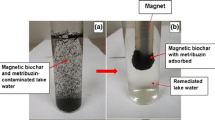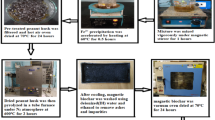Abstract
The present paper presents the evaluation of the adsorption efficiency and adsorption capacity for nitrate removal of magnetic biochar derived from corn stalk prepared by pyrolysis process. Characterization of magnetic biochar have been performed by TGA, XRD, FT-IR and BET methods. The results indicate that the adsorbent has a mesoporous structure graphed with O–H and COOH groups. The effect of various parameters such as pH, mass of Fe3O4-BC adsorbent, contact time, and nitrate concentration on the adsorption process of nitrate were studied. The ranges investigated were pH 4–10, concentration 50–300 ppm, the amount of activated carbon 0.15–0.35 g and contact time 30–120 min. The experimental data show that the prepared magnetic biochar has a nitrate removal efficiency of 98.91% at pH, 50 ppm nitrate concentration, 0.25 g adsorbent and 120 min. The adsorption capacity of the Fe3O4-BC adsorbent was studied by using Response Surface Methodology based on a Box-Behnken design (BBD). The optimum conditions for the equilibrium adsorption capacity (qe) calculated at pH 7, 300 ppm nitrate concentration, 0.15 g adsorbent and 30 min was validated by experimental data and the results are in agreement with the experimental data.








Similar content being viewed by others
References
Marcińczyk M, Oleszczuk P (2022) Biochar and engineered biochar as slow- and controlled-release fertilizers. J Clean Prod 339:130685. https://doi.org/10.1016/j.jclepro.2022.130685
Wang T, Zhang D, Fang K, Zhu W, Peng Q, Xie Z (2021) Enhanced nitrate removal by physical activation and Mg/Al layered double hydroxide modified biochar derived from wood waste: adsorption characteristics and mechanisms. J Environ Chem Eng 9(4):105184. https://doi.org/10.1016/j.jece.2021.105184
Zhou H, Tan Y, Gao W, Zhang Y, Yang Y (2020) Selective nitrate removal from aqueous solutions by a hydrotalcite-like absorbent FeMgMn-LDH. Sci Rep-Uk 10(1):16126. https://doi.org/10.1038/s41598-020-72845-3
World Health Organization (2011) Guidelines for drinking-water quality, 4th edn. World Health Organization, Geneva
Li J, Dong S, Wang Y, Dou X, Hao H (2020) Nitrate removal from aqueous solutions by magnetic cationic hydrogel: effect of electrostatic adsorption and mechanism. J Environ Sci 91:177–188. https://doi.org/10.1016/j.jes.2020.01.029
Ogata F, Imai D, Kawasaki N (2015) Adsorption of nitrate and nitrite ions onto carbonaceous material produced from soybean in a binary solution system. J Environ Chem Eng 3(1):155–161. https://doi.org/10.1016/j.jece.2014.11.025
Song W, Gao B, Xu X, Wang F, Xue N, Sun S et al (2016) Adsorption of nitrate from aqueous solution by magnetic amine-crosslinked biopolymer based corn stalk and its chemical regeneration property. J Hazard Mater 304:280–290. https://doi.org/10.1016/j.jhazmat.2015.10.073
El-Naggar A, Lee SS, Rinklebe J, Farooq M, Song H, Sarmah AK et al (2019) Biochar application to low fertility soils: a review of current status, and future prospects. Geoderma 337:536–554. https://doi.org/10.1016/j.geoderma.2018.09.034
Tan X, Liu Y, Zeng G, Wang X, Hu X, Gu Y et al (2015) Application of biochar for the removal of pollutants from aqueous solutions. Chemosphere 125:70–85. https://doi.org/10.1016/j.chemosphere.2014.12.058
Ahmed MB, Zhou JL, Ngo HH, Guo W, Chen M (2016) Progress in the preparation and application of modified biochar for improved contaminant removal from water and wastewater. Bioresour Technol 214:836–851. https://doi.org/10.1016/j.biortech.2016.05.057
Rezaei Kalantary R, Dehghanifard E, Mohseni-Bandpi A, Rezaei L, Esrafili A, Kakavandi B et al (2016) Nitrate adsorption by synthetic activated carbon magnetic nanoparticles: kinetics, isotherms and thermodynamic studies. Desalin Water Treat 57(35):16445–16455. https://doi.org/10.1080/19443994.2015.1079251
Doukeh R, Bombos D, Bombos M, Oprescu E-E, Dumitrascu G, Vasilievici G et al (2021) Catalytic hydrotreating of bio-oil and evaluation of main noxious emissions of gaseous phase. Sci Rep-Uk 11(1):6176. https://doi.org/10.1038/s41598-021-85244-z
Doukeh R, Bombos M, Bombos D, Vasilievici G, Radu E, Oprescu E-E (2021) Pyrolysis of digestate from anaerobic digestion on tungsten oxide catalyst. Reac Kinet Mech Cat 132(2):829–838. https://doi.org/10.1007/s11144-021-01952-7
Oprescu E-E, Enascuta C-E, Doukeh R, Calin C, Lavric V (2021) Characterizing and using a new bi-functional catalyst to sustainably synthesize methyl levulinate from biomass carbohydrates. Renew Energ 176:651–662. https://doi.org/10.1016/j.renene.2021.05.120
Bombuwala Dewage N, Liyanage AS, Pittman CU, Mohan D, Mlsna T (2018) Fast nitrate and fluoride adsorption and magnetic separation from water on α-Fe2O3 and Fe3O4 dispersed on Douglas fir biochar. Bioresour Technol 263:258–265. https://doi.org/10.1016/j.biortech.2018.05.001
Cataldo DA, Maroon M, Schrader LE, Youngs VL (1975) Rapid colorimetric determination of nitrate in plant tissue by nitration of salicylic acid. Commun Soil Sci Plan 6(1):71–80. https://doi.org/10.1080/00103627509366547
Safari J, Zarnegar Z (2013) A highly efficient magnetic solid acid catalyst for synthesis of 2,4,5-trisubstituted imidazoles under ultrasound irradiation. Ultrason Sonochem 20(2):740–746. https://doi.org/10.1016/j.ultsonch.2012.10.004
Yang H, Yan R, Chen H, Lee DH, Zheng C (2007) Characteristics of hemicellulose, cellulose and lignin pyrolysis. Fuel 86(12):1781–1788. https://doi.org/10.1016/j.fuel.2006.12.013
Frolova L, Kharytonov M (2019) Synthesis of magnetic biochar for efficient removal of Cr(III) cations from the aqueous medium. Adv Mater Sci Eng 2019:2187132. https://doi.org/10.1155/2019/2187132
Li Y, Chen X, Liu L, Liu P, Zhou Z, Huhetaoli et al (2022) Characteristics and adsorption of Cr(VI) of biochar pyrolyzed from landfill leachate sludge. J Anal Appl Pyrol 162:105449. https://doi.org/10.1016/j.jaap.2022.105449
Nautiyal P, Subramanian KA, Dastidar MG (2016) Adsorptive removal of dye using biochar derived from residual algae after in-situ transesterification: alternate use of waste of biodiesel industry. J Environ Manag 182:187–197. https://doi.org/10.1016/j.jenvman.2016.07.063
Vicente-Martínez Y, Caravaca M, Soto-Meca A, Martín-Pereira MÁ, García-Onsurbe MD (2021) Adsorption studies on magnetic nanoparticles functionalized with silver to remove nitrates from waters. Water. https://doi.org/10.3390/w13131757
Nigussie W, Zewge F, Chandravanshi BS (2007) Removal of excess fluoride from water using waste residue from alum manufacturing process. J Hazard Mater 147(3):954–963. https://doi.org/10.1016/j.jhazmat.2007.01.126
Keränen A, Leiviskä T, Hormi O, Tanskanen J (2015) Removal of nitrate by modified pine sawdust: effects of temperature and co-existing anions. J Environ Manag 147:46–54. https://doi.org/10.1016/j.jenvman.2014.09.006
Diriba D, Hussen A, Rao VM (2014) Removal of nitrite from aqueous solution using sugarcane bagasse and wheat straw. Bull Environ Contam Toxicol 93(1):126–131. https://doi.org/10.1007/s00128-014-1297-3
Taoufik N, Elmchaouri A, Korili SA, Gil A (2020) Optimizing the removal of nitrate by adsorption onto activated carbon using response surface methodology based on the central composite design. J Appl Water Eng Res 8(1):66–77. https://doi.org/10.1080/23249676.2020.1723446
Li M, Feng C, Zhang Z, Chen R, Xue Q, Gao C et al (2010) Optimization of process parameters for electrochemical nitrate removal using Box-Behnken design. Electrochim Acta 56(1):265–270. https://doi.org/10.1016/j.electacta.2010.08.085
Singh R, Bhateria R (2020) Optimization and experimental design of the Pb2+ adsorption process on a nano-Fe3O4-based adsorbent using the response surface methodology. ACS Omega 5(43):28305–28318. https://doi.org/10.1021/acsomega.0c04284
Dhahri R, Yılmaz M, Mechi L, Alsukaibi AKD, Alimi F, ben Salem R et al (2022) Optimization of the preparation of activated carbon from prickly pear seed cake for the removal of lead and cadmium ions from aqueous solution. Sustainability 14(6):3245
Saleh TA, Sarı A, Tuzen M (2017) Optimization of parameters with experimental design for the adsorption of mercury using polyethylenimine modified-activated carbon. J Environ Chem Eng 5(1):1079–1088. https://doi.org/10.1016/j.jece.2017.01.032
Aldegs Y, Elbarghouthi M, Elsheikh A, Walker G (2008) Effect of solution pH, ionic strength, and temperature on adsorption behavior of reactive dyes on activated carbon. Dyes Pigment 77(1):16–23. https://doi.org/10.1016/j.dyepig.2007.03.001
Bernal V, Erto A, Giraldo L, Moreno-Pirajan JC (2017) Effect of solution pH on the adsorption of paracetamol on chemically modified activated carbons. Molecules. https://doi.org/10.3390/molecules22071032
Acknowledgements
“This work was supported by a grant of UEFISCDI, project number PN-III-P1-1.1-TE-2019-1842, within PNCDI III”- TE 181/2020.
Author information
Authors and Affiliations
Corresponding author
Additional information
Publisher's Note
Springer Nature remains neutral with regard to jurisdictional claims in published maps and institutional affiliations.
Rights and permissions
About this article
Cite this article
Oprescu, EE., Enascuta, E.C., Vasilievici, G. et al. Preparation of magnetic biochar for nitrate removal from aqueous solutions. Reac Kinet Mech Cat 135, 2629–2642 (2022). https://doi.org/10.1007/s11144-022-02263-1
Received:
Accepted:
Published:
Issue Date:
DOI: https://doi.org/10.1007/s11144-022-02263-1




